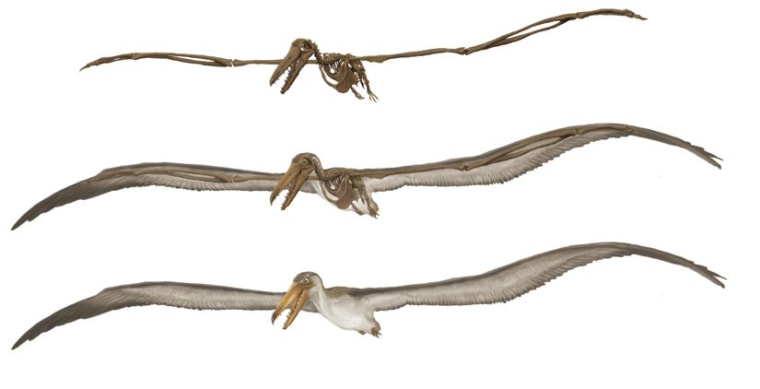Soaring the Chilean skies 5-10 million years ago, an enormous bony-toothed bird has set the world wingspan record. The bird's wingspan was at least 17 feet, according to scientists.
The measurement is based on well preserved wing bones from the newly named bird species, Pelagornis chilensis, a.k.a. "huge pseudoteeth" from Chile. The animal weighed about 64 pounds and belonged to a group known as pelagornithids — birds characterized by long, slender beaks bearing many spiny, tooth-like projections.
It's now thought that 17 feet may be close to the maximum wingspan that can be achieved by a flying bird. Prior wingspan estimates for pelagornithids went up to 20 feet, but they were based on more fragmented fossils.
"Most likely, evolution of such large sizes was to avoid competition with other birds," lead author Gerald Mayr, a paleornithologist at the Senckenberg Research Institute and Natural History Museum, told Discovery News. "Birds with such a large size can, of course, sail across huge distances and may more easily find prey in the open ocean."
However, "there are a number of drawbacks if you become so large," he added. Chicks would have to be raised over a long period of time, making them more prone to predation.
"Moreover," he added, "bird feathers are quite heavy, so very large birds may have become too heavy."
Mayr and paleontologist David Rubilar of Chile's National Museum of Natural History analyzed the big bird's fossilized remains, which are 70 percent complete. The bird is described in the latest issue of the Journal of Vertebrate Paleontology.
This new species was a seabird from northern Chile, but fossils of other bony-toothed birds have been found on other continents. It's likely that all of these species were huge.
The researchers think the birds soared the skies looking for food, such as fish and squid. Once prey was spotted, the birds would cruise across the surface with their lower jaws immersed in the water, grabbing the slippery prey securely with their beaks.
Bony-toothed birds were a very successful group, living during most of the Cenozoic period over a time span of 50-60 million years. They all became extinct approximately 2 million years ago at a time when the Panamanian isthmus between North and South America closed.
Our distant human ancestors may have even watched these boat-sized birds in action. Fossils suggest pelagornithids lived in North Africa during the Pliocene Era.
"If early humans, such as australopithecines or Homo erectus, lived in Morocco by that time and went to the sea, they would have seen these birds," Mayr said.
Mayr thinks it's possible predation by mammals coming over from North America could have wiped out the birds at their breeding grounds, or perhaps they couldn't tolerate resulting changes in sea currents.
Cecile Mourer-Chauvire, a paleornithologist at Claude Bernard University, told Discovery News that she wasn't surprised by the study, since it's been theorized for a while that pelagornithids "were really gigantic flying birds."
Stig Walsh, Senior Curator of Vertebrate Paleontology at National Museums Scotland, also thinks it's "entirely possible the Chilean Pelagornis could have had a wingspan of 17 feet."
Walsh explained that the bird's bones had extremely thin walls, like those of pterosaur bones. "The lightness this must have given their bodies probably contributed to their ability to grow to such a large size," Walsh added.
A life-size reconstruction of Pelagornis chilensis will soon go on display at the Senckenberg Museum in Frankfurt, Germany.
